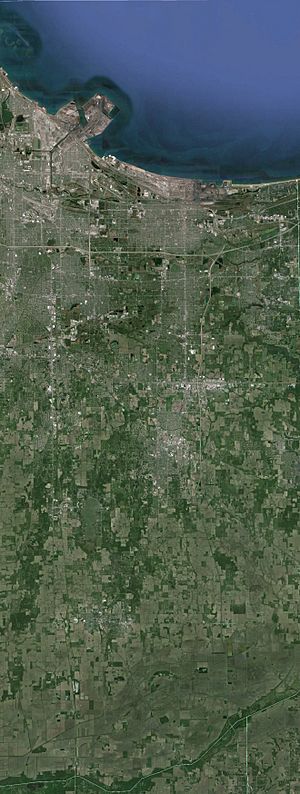Lake County, Indiana facts for kids
Quick facts for kids
Lake County, Indiana
|
||
|---|---|---|
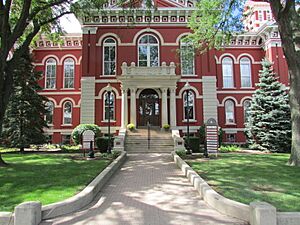
Former Lake County Courthouse
in Crown Point, Indiana |
||
|
||
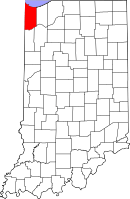
Location in the state of Indiana
|
||
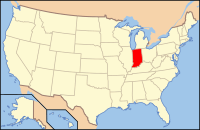
Indiana's location in the U.S.
|
||
| Country | ||
| State | ||
| Region | Northwest Indiana | |
| Metro area | Chicago Metropolitan | |
| Settled | October 1834 | |
| Established | February 16, 1837 | |
| Named for | Lake Michigan | |
| County seat | Crown Point | |
| Largest city | Hammond (population) Gary (total area) |
|
| Incorporated municipalities |
19 cities and towns
Cedar Lake (town)
Crown Point (city) Dyer (town) East Chicago (city) Gary (city) Griffith (town) Hammond (city) Highland (town) Hobart (city) Lake Station (city) Lowell (town) Merrillville (town) Munster (town) New Chicago (town) Schererville (town) Schneider (town) St. John (town) Whiting (city) Winfield (town) |
|
| Government | ||
| • Type | County | |
| • Body | Board of Commissioners | |
| Area | ||
| • County | 626.5 sq mi (1,623 km2) | |
| • Land | 498.9 sq mi (1,292 km2) | |
| • Water | 127.6 sq mi (330 km2) | |
| • Metro | 10,874 sq mi (28,160 km2) | |
| Area rank | 12th largest county in Indiana | |
| • Region | 2,726 sq mi (7,060 km2) | |
| Dimensions | ||
| • Length | 36 mi (58 km) | |
| • Width | 16 mi (26 km) | |
| Elevation
(mean)
|
663 ft (202 m) | |
| Highest elevation
—NE Winfield Twp
|
801 ft (244 m) | |
| Lowest elevation
—at Lake Michigan
|
585 ft (178 m) | |
| Population
(2020)
|
||
| • County | 498,700 | |
| • Estimate
(2023)
|
500,598 |
|
| • Rank | 2nd largest county in Indiana 131st largest county in U.S. | |
| • Density | 796.01/sq mi (307.34/km2) | |
| • Metro | 9,522,434 | |
| • Region | 819,537 | |
| Time zone | UTC−6 (Central) | |
| • Summer (DST) | UTC−5 (Central) | |
| ZIP Codes |
46303, 46307–08, 46311–12, 46319–25, 46327, 46341–42, 46355–56, 46373, 46375–77, 46394, 46401–11
|
|
| Area code | 219 | |
| Congressional district | 1st | |
| Indiana Senate districts | 1st, 2nd, 3rd and 6th | |
| Indiana House of Representatives districts | 1st, 2nd, 3rd, 11th, 12th, 14th, 15th and 19th | |
| FIPS code | 18-089 | |
| GNIS feature ID | 0450495 | |
| Interstates | ||
| U.S. Routes | ||
| State Routes | ||
| Airports | Gary/Chicago International Griffith-Merrillville |
|
| Waterways | Grand Calumet River Indiana Harbor and Ship Canal Kankakee River Lake Michigan |
|
| Amtrak stations | Dyer – Hammond-Whiting
|
|
| South Shore Line stations | Hammond Gateway – East Chicago Adam Benjamin Metro Center Gary/Chicago Airport – Miller |
|
| Public transit | East Chicago Transit Gary Public Transportation Broadway Metro Express |
|
| Website | www.lakecountyin.org | |
|
||
Lake County is a county located in the state of Indiana, in the United States. It's known for being part of Northwest Indiana and the larger Chicago metropolitan area. In 2020, about 498,700 people lived here, making it the second-most populated county in Indiana.
The main city, or county seat, is Crown Point. Lake County has a mix of busy cities, suburban neighborhoods, and quiet rural areas. It's right next to Lake Michigan on its northern side and includes part of the beautiful Indiana Dunes.
Contents
- History of Lake County
- Geography and Landscape
- Cities and Towns in Lake County
- Economy and Jobs in Lake County
- Education in Lake County
- Public Libraries in Lake County
- Hospitals in Lake County
- Media in Lake County
- Climate and Weather in Lake County
- Fun Things to Do in Lake County
- Population and People of Lake County
- See also
History of Lake County
How Lake County Was Formed
Long ago, the Potawatomi people and other native groups lived in this area. Lake County was officially created by European Americans on February 16, 1837. Before that, it was part of other counties. It got its name because it's located right on Lake Michigan.
The first county seat was a place called Liverpool. But in 1840, a new spot named Lake Court House was chosen. This place later became known as Crown Point.
Growth and Industry in the Early Days
Lake County grew slowly at first. But in the 1850s, things changed! New railroads were built to connect Chicago to other parts of the country. This brought many new settlers and immigrants to the area.
Small factories started to appear, mostly along the northern coast. This was a good spot because they could use the railroads and ship goods on the Great Lakes. By 1900, the county had about 37,892 residents.
Big Changes with Factories and New People
In the early 1900s, huge steel companies like Inland Steel Company and U.S. Steel built large factories here. These factories needed many workers, so the county's population grew very quickly!
People came from all over Europe, and also from other parts of the United States. Many African Americans moved north during the Great Migration. They were looking for factory jobs and a better life away from unfair laws in the South.
By 1930, Lake County had over 260,000 people. Most of them were either immigrants or their children. Besides steel, other industries also came to Lake County. They liked the affordable land and good transportation. These included companies making cars, oil, chemicals, and food products.
Tough Times and New Beginnings
The Great Depression in the 1930s was very hard on Lake County. Many people lost their jobs because the factories struggled. This period also led to big changes in local politics. Lake County became a strong supporter of the Democratic Party.
During World War II, the factories became busy again to support the war. This brought back good jobs and prosperity. This good economic time lasted until the 1970s. Unions helped factory workers earn good wages.
After the war, even more people moved to Lake County. But as cities grew older, many families moved to newer homes in the suburbs.
Lake County Today
Lake County's population was highest in 1970, with about 546,000 people. After that, many factories started to close or hire fewer workers. This was due to competition and new technologies. For example, steel jobs dropped a lot.
Because of this, the county's population went down for a while. It reached its lowest point in 1990 with about 475,000 people. The economy also changed, and average incomes became lower compared to the rest of the country.
However, the population started to grow again in the 1990s and 2000s. Many people now live in the suburbs and travel to Chicago for work. They use highways or the South Shore Line train. Even though there are still challenges, Lake County continues to adapt and grow.
Geography and Landscape
Lake County covers about 626.56 square miles. About 498.96 square miles is land, and 127.60 square miles is water. It has the most water area of all 92 counties in Indiana!
The northern and southern parts of the county are mostly flat. They used to be very marshy and needed to be drained. The lowest point is along the Lake Michigan shoreline, at 585 feet above sea level.
The middle part of the county is higher and has more hills. As you go south from the flat lake area, the land rises to the Valparaiso Moraine. The highest point is 801 feet, located in northeastern Winfield Township. From there, the land slopes down to the Kankakee River.
Important Natural Areas
- Indiana Dunes National Park – This beautiful park is shared with LaPorte and Porter counties.
How to Get Around Lake County
Public Transportation
- East Chicago Transit
- Gary Public Transportation Corporation (including the Broadway Metro Express)
Airports
- Gary/Chicago International Airport
- Griffith-Merrillville Airport
Major Roads and Highways
Lake County has many important roads that help people travel.
 Interstate 65 is called the Casimir Pulaski Memorial Highway.
Interstate 65 is called the Casimir Pulaski Memorial Highway. Interstate 80,
Interstate 80,  Interstate 94, and
Interstate 94, and  U.S. Route 6 form the Frank Borman Expressway.
U.S. Route 6 form the Frank Borman Expressway. Indiana Toll Road
Indiana Toll Road U.S. Route 12 (Dunes Highway)
U.S. Route 12 (Dunes Highway) U.S. Route 20
U.S. Route 20 U.S. Route 30 is part of the historic Lincoln Highway.
U.S. Route 30 is part of the historic Lincoln Highway. U.S. Route 41
U.S. Route 41 U.S. Route 231
U.S. Route 231 State Road 2
State Road 2 State Road 51 (Adam Benjamin Memorial Highway)
State Road 51 (Adam Benjamin Memorial Highway) State Road 53 (Carolyn Mosby Memorial Highway)
State Road 53 (Carolyn Mosby Memorial Highway) State Road 55
State Road 55 State Road 130
State Road 130 State Road 152
State Road 152 State Road 312
State Road 312 State Road 912 (Highway Construction Workers Memorial Highway)
State Road 912 (Highway Construction Workers Memorial Highway)
Railroads
- Amtrak
- Canadian National Railway
- Chicago, Fort Wayne and Eastern Railroad
- Chicago South Shore and South Bend Railroad
- CSX Transportation
- Gary Railway
- Indiana Harbor Belt Railroad
- Norfolk Southern Railway
- South Shore Line
Neighboring Counties
Lake County shares borders with several other counties:
- Cook County, Illinois (to the northwest)
- Will County, Illinois (to the west)
- Kankakee County, Illinois (to the southwest)
- Porter County (to the east)
- Jasper County (to the southeast)
- Newton County (to the south)
Cities and Towns in Lake County
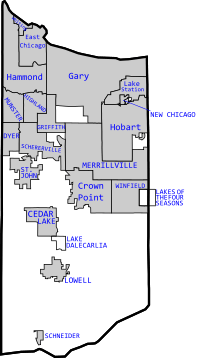
Lake County has many different communities. Here are some of the main cities and towns, with their populations from the 2020 Census:
Cities in Lake County
- Crown Point – 33,899 people
- East Chicago – 26,370 people
- Gary – 69,093 people
- Hammond – 77,879 people
- Hobart – 29,752 people
- Lake Station – 13,235 people
- Whiting – 4,559 people
Towns in Lake County
- Cedar Lake – 14,106 people
- Dyer – 16,517 people
- Griffith – 16,528 people
- Highland – 23,984 people
- Lowell – 10,680 people
- Merrillville – 36,444 people
- Munster – 23,894 people
- New Chicago – 1,999 people
- Schererville – 29,646 people
- Schneider – 269 people
- St. John – 20,303 people
- Winfield – 7,181 people
Other Communities
There are also smaller communities called census-designated places (CDPs) and unincorporated communities. These are areas that don't have their own local government like cities or towns.
Census-Designated Places
- Lake Dalecarlia – 1,332 people
- Lakes of the Four Seasons – 3,936 people (partially in Porter County)
- Shelby – 453 people
Unincorporated Communities
- Ainsworth
- Belshaw
- Brunswick
- Creston
- Deep River
- Deer Creek
- Dinwiddie
- Green Acres
- Illinoi (partial)
- Klaasville
- Kreitzburg
- Leroy
- Liverpool
- New Elliott
- Orchard Grove
- Palmer
- Range Line
- Ross
- Southeast Grove
Townships in Lake County
Lake County is divided into 11 townships. Here are their populations from the 2020 Census:
- Calumet – 91,970 people
- Cedar Creek – 12,725 people
- Center – 38,630 people
- Eagle Creek – 1,719 people
- Hanover – 18,214 people
- Hobart – 40,652 people
- North – 156,686 people
- Ross – 48,529 people
- St. John – 68,972 people
- West Creek – 7,676 people
- Winfield – 12,927 people
Economy and Jobs in Lake County
Even though many big factories have changed, manufacturing is still a very important part of Lake County's economy. In 2010, over 45,000 people worked in manufacturing.
Other big job areas include:
- Healthcare and social assistance (like hospitals and clinics)
- Public administration (government jobs)
- Retail trade (stores and shops)
- Food services (restaurants)
- Construction (building things)
In 2010, Lake County's total economic output was almost $25 billion. Manufacturing was the biggest part of this, contributing over $5.8 billion.
Major Employers in Lake County
Many businesses have a large number of employees in the county:
- Americall Group, Inc. – Hobart
- Ameristar Casino – East Chicago
- BP Whiting Refinery – Whiting
- Canadian National Railway – Whiting
- Cargill – Hammond
- Cleveland-Cliffs Indiana Harbor Works – East Chicago
- Community Hospital – Munster
- Franciscan Alliance, Inc. – various locations
- Hard Rock Casino Northern Indiana – Gary
- Horseshoe Casino – Hammond
- Methodist Hospitals Northlake Campus – Merrillville
- NiSource – Merrillville
- St. Catherine Hospital – East Chicago
- St. Mary Medical Center – Hobart
- Times Media Company – Munster
- Unilever – Whiting
- U.S. Steel Gary Works – Gary
Education in Lake County
Lake County has many schools and colleges. Public schools are managed by 16 different school districts.
Public School Districts
- Crown Point Community School Corporation
- Gary Community School Corporation
- Griffith Public Schools
- Hanover Community School Corporation
- Lake Central School Corporation
- Lake Ridge Schools Corporation
- Lake Station Community Schools
- Merrillville Community School Corporation
- River Forest Community School Corporation
- School City of East Chicago
- School City of Hammond
- School City of Hobart
- School City of Whiting
- School Town of Highland
- School Town of Munster
- Tri-Creek School Corporation
Private Schools
Many private schools are run by the Diocese of Gary:
- Andrean High School, Merrillville (grades 9–12)
- Aquinas School at St. Andrew's, Merrillville (Pre-K–grade 8)
- Bishop Noll Institute, Hammond (grades 9–12)
- Our Lady of Grace, Highland (Pre-K–grade 8)
- St. Casimir, Hammond (Pre-K–grade 8)
- St. John Bosco, Hammond (Pre-K–grade 8)
- St. John the Baptist, Whiting (Pre-K–grade 8)
- St. John the Evangelist, St. John (Pre-K–grade 8)
- St. Mary, Crown Point (Pre-K–grade 8)
- St. Mary, Griffith (Pre-K–grade 8)
- St. Michael, Schererville (Pre-K–grade 8)
- St. Stanislaus, East Chicago (Pre-K–grade 8)
- St. Thomas More, Munster (Pre-K–grade 8)
Other private schools include:
- St. Paul's Lutheran School, Munster (Pre-K–grade 8)
- Trinity Lutheran School, Crown Point (Pre-K–grade 8)
- Trinity Lutheran School, Hobart (Pre-K–grade 8)
Colleges and Universities
Lake County is home to several colleges and universities:
- Calumet College of St. Joseph
- Hyles–Anderson College
- Indiana University Northwest
- Ivy Tech Community College
- Purdue University Northwest
- University of Phoenix
- Indiana Wesleyan University
Public Libraries in Lake County
Seven different public library systems serve the county:
- Crown Point Community Library (with a branch in Winfield)
- East Chicago Public Library (main and Robart A. Pastrick branch)
- Gary Public Library (main, Du Bois, Brunswick, Kennedy, and Woodson branches)
- Hammond Public Library
- Lake County Public Library (main in Merrillville, with branches in Cedar Lake, Dyer-Schererville, Griffith-Calumet Township, Highland, Hobart, Lake Station-New Chicago, Munster, and St. John)
- Lowell Public Library (with branches in Schneider and Shelby)
- Whiting Public Library
Hospitals in Lake County
Lake County has several hospitals that provide healthcare services:
- Community Hospital, Munster – 454 beds
- Franciscan Health Crown Point, Crown Point – 203 beds
- Franciscan Health Dyer, Dyer – 223 beds
- Franciscan Health Munster, Munster – 63 beds
- Methodist Hospitals – 536 beds (Northlake Campus in Gary, Southlake Campus in Merrillville)
- NW Indiana ER and Hospital, Hammond – 6 beds
- St. Catherine Hospital, East Chicago – 216 beds
- St. Mary Medical Center, Hobart – 215 beds
- UChicago Medicine Crown Point, Crown Point – 8 beds (opening April 2024)
Media in Lake County
Lake County has its own newspapers, TV, and radio stations.
Newspapers
- The Times, based in Munster, is the largest daily newspaper in the area.
- The Post-Tribune, based in Merrillville, is another daily newspaper.
Television
- Lakeshore Public Television runs WYIN-TV Gary on channel 56. It's the local PBS station for the Chicago TV market.
Radio Stations
Eight broadcast radio stations serve Lake County:
- WJOB (1230 AM) – Hammond
- WWCA (1270 AM) – Gary
- WLTH (1370 AM) – Gary
- WLPR (89.1 FM) – Lowell
- WRTW (90.5 FM) – Crown Point
- WPWX (92.3 FM) – Hammond
- WXRD (103.9 FM) – Crown Point
- WZVN (107.1 FM) – Lowell
Climate and Weather in Lake County
The weather in Lake County changes a lot throughout the year.
- In January, the average low temperature in Lowell is about 14.4°F.
- In July, the average high temperature is about 83.8°F.
- The coldest temperature ever recorded was -29°F in December 1989.
- The hottest temperature ever recorded was 104°F in June 1988.
Rainfall varies, with about 1.75 inches in February and 4.69 inches in June.
- Temperatures below 0°F happen about 11 days a year.
- Temperatures above 90°F happen about 14 days a year.
- In winter, areas near the lake get more snow because of "lake-effect snow."
- In spring and early summer, a "lake-breeze" can make areas near the shoreline cooler.
- Thunderstorms are common in summer, happening 40–50 days each year. Some of these storms can bring strong winds.
Fun Things to Do in Lake County
Lake County offers many places for entertainment, arts, and recreation.
Entertainment and Arts
- Northwest Indiana Symphony Orchestra: They perform concerts at Living Hope Church in Merrillville.
- Theatre at the Center: You can watch shows here at the Center for Visual and Performing Arts in Munster.
Major Attractions
- Ameristar Casino – East Chicago
- Horseshoe Casino – Hammond
- Majestic Star Casino – Gary
- Majestic Star Casino II – Gary
- Pierogi Fest – A popular festival in Whiting.
- Southlake Mall – Hobart
- Three Floyds Brewing – Munster
Professional Sports
- Gary SouthShore RailCats: This professional baseball team plays their games at U.S. Steel Yard in Gary.
Parks and Recreation
Lake County has many parks and recreational spots for outdoor fun:
- Bellaboo's Play and Discovery Center – Lake Station
- Buckley Homestead – Lowell
- Cedar Creek Family Golf Center – Cedar Lake
- Deep River County Park – Hobart
- Deep River Waterpark – Crown Point
- Gibson Woods Nature Preserve – Hammond
- Grand Kankakee Marsh – Hebron
- Lake Etta – Gary
- Lemon Lake – Crown Point
- Oak Ridge Prairie & Oak Savannah Trail – Griffith
- Stoney Run County Park – Hebron
- Three Rivers County Park – Lake Station
- Turkey Creek Golf Course – Merrillville
- Whihala Beach – Whiting
Recreational Facilities in Indiana Dunes National Park
- Calumet Prairie State Nature Preserve – Lake Station
- Hobart Prairie Grove – Hobart
- Hoosier Prairie State Nature Preserve – Griffith
- Paul H. Douglas Center for Environmental Education – Gary
Population and People of Lake County
Lake County is a diverse place with people from many different backgrounds.
Population Changes Over Time
The population of Lake County has changed quite a bit over the years:
- 1840: 1,468 people
- 1900: 37,892 people
- 1930: 261,310 people
- 1970: 546,253 people (highest population)
- 1990: 475,594 people (lowest recent population)
- 2020: 498,700 people
Who Lives in Lake County?
Based on the 2020 Census, here's a look at the different groups of people living in Lake County:
- White (not Hispanic/Latino): 50.35%
- Black or African American (not Hispanic/Latino): 24.27%
- Asian: 1.47%
- Native American or Alaska Native: 0.14%
- Pacific Islander: 0.02%
- Other race (not Hispanic/Latino): 0.34%
- Mixed race: 3.37%
- Hispanic or Latino (of any race): 20.04%
In 2010, the average age in Lake County was 37.4 years old.
- About 34.3% of households had children under 18 living with them.
- The average household had 2.60 people.
- The average family had 3.19 people.
The median income for a household in 2010 was $47,697. This means half of the households earned more than this, and half earned less. For families, the median income was $58,931.
See also
 In Spanish: Condado de Lake (Indiana) para niños
In Spanish: Condado de Lake (Indiana) para niños



